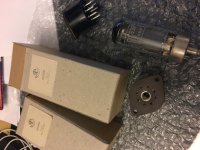Hi,
I've got a bunch of Svetlana =C= 6P1P-EV tubes laying in my stashes and a pair of Hammond JR-20 tone cabinets that needs new output tubes, four 6V6's per device. Instead of buying new 6V6's, I decided to use my 6P1P's and build adapters, using the penolic bases of worn out octal tubes and noval sockets. The 6P1P datasheet shows that the cathode, screen grid and plate connctions are brought out to two pins each. Is it advisable to connect each of the two pins to the relative pin of the octal base or is one pin sufficient? Furthermore, is it a good idea to integrate smallish cathode resistors of, say, 10 ohms into the adapters to ease tube matching/selecting?
Best regards!
I've got a bunch of Svetlana =C= 6P1P-EV tubes laying in my stashes and a pair of Hammond JR-20 tone cabinets that needs new output tubes, four 6V6's per device. Instead of buying new 6V6's, I decided to use my 6P1P's and build adapters, using the penolic bases of worn out octal tubes and noval sockets. The 6P1P datasheet shows that the cathode, screen grid and plate connctions are brought out to two pins each. Is it advisable to connect each of the two pins to the relative pin of the octal base or is one pin sufficient? Furthermore, is it a good idea to integrate smallish cathode resistors of, say, 10 ohms into the adapters to ease tube matching/selecting?
Best regards!
I have done that. I just picked one pin that is closest to the corresponding 6V6 pin and ignore the other one. I did not have any issue.
I think you can add the 10 ohm resistor if you have enough space to do so.
The challenge will actually be how to secure the top and bottom plate together when you pull or insert a tube into the converter or the socket. I ended up to fill the gap with epoxy.
I think you can add the 10 ohm resistor if you have enough space to do so.
The challenge will actually be how to secure the top and bottom plate together when you pull or insert a tube into the converter or the socket. I ended up to fill the gap with epoxy.
Multiple pins per electrode reduces lead inductance at radio frequencies. But this bottle says "low frequency".
On some audio power tubes an extra pin is claimed to improve electrode cooling. Maybe 7027? Some other studies suggest a part-Watt can be extracted this way, so against a tight specification it might turn a marginal fail into a marginal pass.
I'd tend to put an inch of wire on all of any hot electrode's pins.
Your tube has two K connections and we typically don't want to cool K. However extra pins may be mechanical support.
On some audio power tubes an extra pin is claimed to improve electrode cooling. Maybe 7027? Some other studies suggest a part-Watt can be extracted this way, so against a tight specification it might turn a marginal fail into a marginal pass.
I'd tend to put an inch of wire on all of any hot electrode's pins.
Your tube has two K connections and we typically don't want to cool K. However extra pins may be mechanical support.
Same with 6KG6A/EL519, maybe, which has any of it's electrodes (besides the beam plates) being brought out at two pins of it's magnoval base?
Best regards!
Best regards!
I did a similar exercise to use loctal 5B/255M in place of KT66 in Quad 2s. There were also pins that shared connections to the internal electrodes, and I just selected the easiest match between the pin of the top base and the octal base.
In hindsight, when I looked at 7C5 tubes, which are loctal 6V6 tubes, I noticed that there are standard pins out for loctal power tubes, but because I had not used the same cathode pin on my original attempt, my converter bases only worked for one tube type instead of being generic.
The octal bases are very cheap on eBay - $1 each I think.
I used the phenolic sheet wafer type bases on top so it fitted flush to the top, and was easy to glue together. I think I also added a ferrite bead on the grid pin, because I was worried about the extra wire length.
In hindsight, when I looked at 7C5 tubes, which are loctal 6V6 tubes, I noticed that there are standard pins out for loctal power tubes, but because I had not used the same cathode pin on my original attempt, my converter bases only worked for one tube type instead of being generic.
The octal bases are very cheap on eBay - $1 each I think.
I used the phenolic sheet wafer type bases on top so it fitted flush to the top, and was easy to glue together. I think I also added a ferrite bead on the grid pin, because I was worried about the extra wire length.
Attachments
Last edited:
